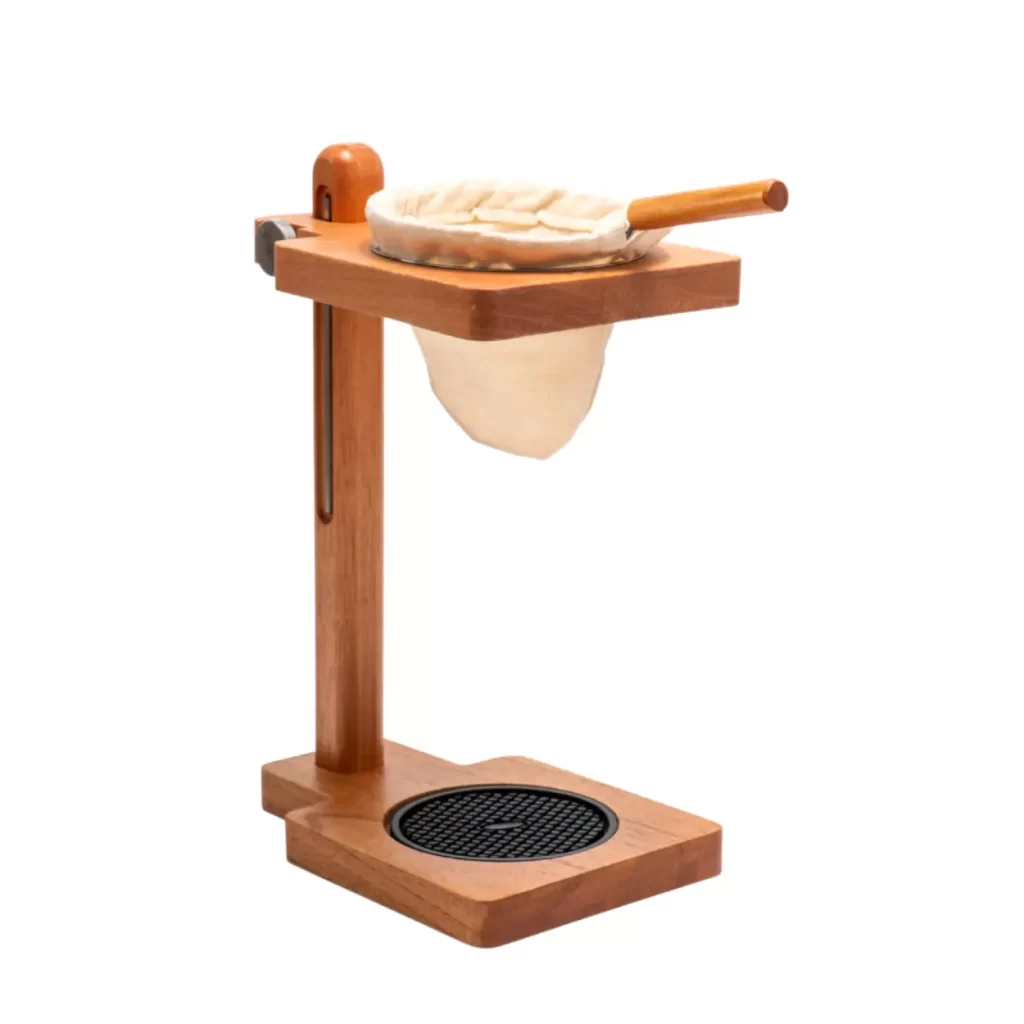In the world of coffee aficionados, few things evoke as much sentimental reverence and cultural significance as Costa Rica’s traditional Chorreador de Café. This unique Costa Rican coffee maker is more than just an appliance; it is a ritualistic symbol deeply rooted in the nation’s heritage. With its simple yet thoughtfully designed components, the Chorreador offers an artisanal approach to coffee brewing that celebrates the richness of Costa Rican coffee culture. In this comprehensive guide, we will delve into the nuanced details of the Chorreador—from its basic design elements to its ceremonial brewing process and cultural impact—offering an in-depth look into why this method has stood the test of time. Prepare to journey into the heart of Costa Rican tradition, where each cup of coffee serves as a liquid testament to history, craftsmanship, and the art of slow living.
Costa Rican Coffee Maker: Key Takeaway
- Traditional Craftsmanship: The Chorreador de Café is a unique Costa Rican coffee maker that emphasizes simplicity and traditional craftsmanship. Its wooden stand and cloth filter are designed to bring out the rich flavors of Costa Rican coffee beans.
- In-Depth Brewing Guide: Mastering the art of brewing with a Chorreador involves understanding the right coffee-to-water ratio, grind size, and following the step-by-step brewing process. Proper technique can elevate your coffee experience to new heights.
- Cultural Importance: Coffee has been deeply integrated into Costa Rican culture and history. The Chorreador is not just a brewing method but a cultural artifact that symbolizes the Costa Rican approach to life and community.
- Maintenance Tips: Proper care of your Chorreador extends its longevity and ensures consistently great coffee. Key points include never using soap on the cloth filter, and occasional cleaning with salt to maintain the filter’s condition.
- Costa Rican Coffee Culture: Beyond just brewing, the article also delves into how locals savor their coffee, the traditional foods paired with it, and how coffee tourism has become a must-do experience in Costa Rica.
What is a Chorreador de Café (Chorreador de Café)?

A Chorreador de Café is more than just a tool for making coffee; it’s a time-honored Costa Rican tradition that serves as a cultural emblem as much as a functional appliance. Known for its simplicity and effectiveness, the Chorreador stands as a minimalist wooden frame that holds a cloth filter, locally called a “bolsita,” from which freshly brewed coffee drips down into a waiting cup or carafe. In an age of automated machines and high-speed brewing, the Chorreador offers a tranquil, almost meditative, way of preparing coffee that many believe enhances its flavors and aromas.
Design and Components

The beauty of the Chorreador’s design lies in its uncomplicated yet functional architecture. While variants exist, the core elements remain the same: (1)
- Wooden Frame: Usually made from local woods like Costa Rican Gmelina or Spanish Cedar, the frame provides a sturdy base and a support arm to hang the filter.
- Bolsita (Cloth Filter): Typically made of cotton, this reusable filter hangs from the frame’s arm, accommodating the coffee grounds.
- Collection Vessel: A cup, mug, or carafe is placed under the hanging filter to catch the brewed coffee.
Though simple, the chorreador is thoughtfully designed, taking into account factors such as the cloth’s permeability, which allows essential oils and flavors to pass through, and the wood’s resistance to moisture.
Cultural Significance

The chorreador is not merely a coffee maker but a piece of Costa Rican heritage. Its significance transcends its function, acting as a symbol of a lifestyle that values tradition, craftsmanship, and the simple pleasures in life. Families pass down chorreadors from generation to generation, and the act of brewing coffee often becomes a communal experience, a time for conversation and bonding. The chorreador epitomizes a slower, more deliberate approach to life, reminding us that sometimes the best things are worth waiting for.
The Chorreador de Café is an icon of Costa Rican culture, designed with both functionality and tradition in mind. Its brewing process, though simple, offers a richer, more nuanced cup of coffee, turning the act of coffee-making into a meaningful ritual.
Best Costa Rican Coffee Maker
When it comes to Costa Rican coffee, the method of preparation is almost as important as the beans themselves. With a rich heritage of coffee making, Costa Rica offers some of the most unique and traditional coffee makers. These pour-over stands provide a coffee experience like no other, allowing you to savor every aromatic drop. Today, we are reviewing three standout brands in the Costa Rican coffee maker space: PLINC Chorreador, Handmade Chorreador by Love Gourmet Coffee, and Butterfly Chorreador by Love Gourmet Coffee.
PLINC Chorreador

If you’re someone who values both tradition and innovation in your coffee-making ritual, the PLINC Chorreador is your go-to choice. Built as a harmonious blend of the old and the new, this coffee maker is a sublime homage to the Costa Rican method of brewing, known locally as “Un cafe chorreado.” The design elevates your sensory experience, presenting you with a cup that offers not just a caffeine kick, but a voyage through Costa Rica’s coffee culture.
- Color: Natural Wood
- Product Dimensions: 8″D x 5.5″W x 12″H
- Special Feature: Portable
- Coffee Maker Type: Pour Over
The true genius of the PLINC Chorreador lies in its commitment to material excellence. Fashioned from Spanish Cedar wood and accented by stainless steel, it carries an adjustable height system that caters to coffee aroma retention. The crown jewel of the maker is its 100% unbleached cotton filter, selected after rigorous tests and blind cupping sessions with coffee champions. Trust me, if you’re looking for a full-bodied and aromatic coffee, this is where your search ends.
Handmade Chorreador by Love Gourmet Coffee

- Costa Rica is known for their gourmet coffees. Brew your coffee in the traditional way that it is made in Costa Rica
For those who crave an authentic Costa Rican coffee experience with a touch of artistic flair, look no further than the Handmade Chorreador by Love Gourmet Coffee. This piece is not just a coffee maker; it’s an art form. The hand-painted blue butterfly adds an aesthetic dimension to the piece that is deeply ingrained in Costa Rican culture.
- Capacity: 10 Cups
- Color: Natural wood, hand-painted blue butterfly
- Product Dimensions: 4.75″D x 0.75″W x 11.75″H
- Special Feature: Hand-made and hand-painted, foldable chorreador
Beyond its eye-catching design, the Handmade Chorreador also excels in functionality. It offers a foldable design perfect for travel and camping. What makes this coffee maker stand out is its capacity for flexibility—you can brew anywhere from a single cup to a full 10-cup pot. If you appreciate not just the taste but also the craft of coffee-making, this hand-painted gem will elevate your daily ritual to a work of art.
Butterfly Chorreador by Love Gourmet Coffee

The Butterfly Chorreador by Love Gourmet Coffee is designed for the tech-savvy individual who appreciates the touch of tradition. It’s the epitome of modern convenience meeting historical artistry. From the carved relief to the painted orange butterfly, this Chorreador is a visual feast as much as it is a coffee-making apparatus.
- Capacity: 1005.5 Milliliters
- Color: Mahogany
- Special Feature: Programmable, Thermal
- Coffee Maker Type: Pour Over
Unlike other models, the Butterfly Chorreador comes with programmable features and a thermal aspect that keeps your coffee hot for longer. The inclusion of a cloth coffee strainer rounds off this pour-over set perfectly. If you’re the kind who likes to schedule their day right down to their coffee breaks but doesn’t want to compromise on quality and aesthetics, this is the Costa Rican coffee maker for you.
Ultimately, each of these coffee makers offers a unique blend of tradition, innovation, and artistry, ensuring that your Costa Rican coffee experience is nothing short of exceptional. Choose based on your lifestyle and aesthetic preferences, and you can’t go wrong.
Traditional Chorreador vs. Modern Machines

In the arena of coffee making, two distinct philosophies are often pitted against each other: the traditional Chorreador approach versus modern, automated coffee machines. While both have their merits, they cater to different sensibilities and values. One champions a return to basics, rooted in cultural tradition, while the other seeks the pinnacle of convenience and technological innovation. Understanding the materials and design can help potential buyers make an informed decision. Furthermore, knowing where to buy an authentic Costa Rican coffee maker can elevate your coffee experience to a whole new level.
Materials and Design: What to Look For
In a traditional Chorreador, materials, and design are all about simplicity and function:
- Wooden Frame: Opt for local woods like Spanish Cedar or Costa Rican Gmelina for a more authentic experience. These woods are not only sturdy but also resistant to moisture.
- Cloth Filter (Bolsita): Usually made of unbleached cotton, the bolsita allows essential oils to pass through, enriching the flavor of the coffee.
- No Electricity: One of the most appealing aspects is its lack of reliance on electricity, making it eco-friendly and portable.
On the flip side, modern coffee machines often feature:
- Stainless Steel or Plastic: Built primarily for durability and ease of cleaning.
- Paper or Metal Filters: These can sometimes trap essential oils, leading to a less flavorful cup.
- Electricity-Dependent: Most modern machines need to be plugged in, limiting their portability.
When weighing your options, consider what you value more: the rich, full-bodied flavor and cultural experience offered by the chorreador or the speed and convenience of a modern machine.
Where to Buy Authentic Costa Rican Coffee Makers
If you’re keen on experiencing coffee brewing as an art form, buying an authentic chorreador is crucial. While online platforms like Etsy or specialized coffee supply stores might offer a range of options, nothing beats purchasing directly from Costa Rican artisans if possible. Local markets in Costa Rica often sell handcrafted chorreadors, which not only support local artisans but also assure you’re getting an authentic product. Websites specializing in Costa Rican products might also provide quality chorreadors, but be sure to check for certifications or customer reviews to ensure authenticity.
Overall, the choice between a traditional Chorreador and a modern coffee machine comes down to what you prioritize: cultural richness and flavor, or speed and convenience. Knowing what to look for in materials and design can guide you in making a more educated choice while understanding where to purchase an authentic product ensures you experience coffee making at its most genuine.
Mastering the Art of Brewing with a Costa Rican Coffee Maker
When it comes to coffee brewing, a Costa Rican coffee maker, also known as a Chorreador, offers a unique approach that celebrates both tradition and flavor. This simplistic yet effective tool embodies the idea that great coffee is an art form requiring patience, skill, and a deep understanding of the fundamentals. Mastering the art of brewing with a Chorreador involves a fine-tuning of variables such as the coffee-to-water ratio, the grind size, and the actual brewing process. In this section, we will delve into each of these elements to help you achieve the perfect cup of coffee.
The Perfect Coffee-to-Water Ratio

Achieving the right balance between coffee and water is critical for extracting the full range of flavors without venturing into the territories of either bitterness or blandness.
- Standard Ratio: A good starting point is to use approximately 1 gram of coffee for every 15-17 grams of water.
- Adjust to Taste: The above ratio can be adjusted based on personal preference. A 1:15 ratio will yield a stronger cup, while a 1:17 ratio will produce a lighter brew.
- Consistency: Consistently using the same measuring tools will ensure a reliably delicious cup every time.
Choosing the perfect ratio is an experimental journey. Feel free to tweak the numbers until you arrive at the brew strength that suits your palate.
Grind Size and Type of Coffee

The grind size and the type of coffee bean you use can significantly impact the taste of your brew.
- Fine to Medium-Fine: This is ideal for a chorreador because it ensures even water flow and optimal extraction.
- High-Quality, Fresh Beans: Opt for high-quality beans, preferably sourced from Costa Rican farms to keep the experience as authentic as possible.
- Roast Level: Lighter roasts typically yield more acidic, nuanced flavors, while darker roasts offer a fuller, bolder profile.
Remember, fresh is best when it comes to coffee. Grind your beans just before brewing for the most flavorful outcome.
Step-by-Step Brewing Guide

Once you’ve determined your ideal coffee-to-water ratio and grind size, you’re ready to brew.
- Preparation: Boil water and let it sit for about 30 seconds to bring it off the boil. Place your coffee grounds into the cloth filter (bolsita).
- Wet the Grounds: Pour a small amount of hot water over the coffee grounds to pre-wet them. This helps to bloom the coffee, releasing any excess gas and prepping the coffee for optimal extraction.
- Pouring Technique: Gently pour the remaining hot water over the coffee grounds in a slow, circular motion, starting from the center and working your way outward.
- Dripping Time: Allow the coffee to drip through the cloth filter into your cup or carafe. This may take a few minutes.
- Enjoy: Once all the water has passed through the filter, your coffee is ready to be enjoyed.
Becoming proficient at brewing coffee with a Chorreador is an exercise in patience and refinement. By focusing on the perfect coffee-to-water ratio, selecting the right grind size, and following a thoughtful brewing process, you’ll not only produce an exceptional cup of coffee but also gain a deeper appreciation for this venerable Costa Rican tradition.
Maintenance and Care for Your Coffee Maker
Owning a traditional Costa Rican coffee maker, or chorreador comes with the responsibility of ensuring its longevity and optimal functioning. While the chorreador is a fairly straightforward device, some care and maintenance are required to keep it at its best. From cleaning and preserving the cloth filter to troubleshooting common issues and adopting sustainable practices, here are some tips for taking care of your chorreador.
Cleaning and Preserving the Chorreador

Keeping your chorreador clean is key to consistently brewing a delicious cup of coffee. Here’s how you can maintain it:
- Daily Cleaning: It’s essential to rinse the chorreador after each use. Especially focus on the cloth filter, also known as the ‘bolsita,’ using only water.
- Weekly Deep Cleaning: About once a week, run the cloth filter under water and then apply a handful of salt to it. Rub the salt thoroughly into the fabric. This acts as a natural cleaner. Make sure to rinse the filter thoroughly afterward.
- Natural Stains: Over time, the cloth filter may start to brown. Don’t fret—this is natural and doesn’t affect the quality of your brew.
Preserving your chorreador is simple but crucial. A little attention to detail will prolong the life of the coffee maker and the filter, enhancing your overall coffee experience.
Common Issues and How to Fix Them
While chorreadors are fairly resilient, they are not entirely without their issues. Here are some common problems and their solutions:
- Stained Bolsita: If the filter starts to look exceptionally dirty, despite cleaning, it’s time to replace it. Filters can last anywhere from a few months to several years, depending on usage and maintenance.
- Slow Drip: If you notice the coffee is taking too long to filter through, the bolsita may be clogged.
Try the salt-cleaning method described above. If that doesn’t work, consider replacing the filter.
Keeping an eye out for these issues and addressing them promptly ensures that your chorreador remains a reliable tool for your daily coffee ritual.
Sustainability Tips: Making Coffee the Eco-Friendly Way
Chorreadors inherently offer a more eco-friendly coffee brewing option compared to electric coffee makers. Here are some additional sustainability tips:
- Zero-Waste Filter: The reusable cloth filter eliminates the need for paper filters, reducing waste.
- No Electricity Needed: The manual nature of the chorreador means it doesn’t consume any electricity, making it more energy-efficient.
- Local Sourcing: If possible, use coffee beans that are locally sourced and sustainably grown, to minimize your carbon footprint.
Embracing these eco-friendly practices aligns perfectly with the inherent sustainability of the chorreador, allowing you to enjoy your coffee with a clear conscience.
Ultimately, proper maintenance and care of your Chorreador not only prolong its lifespan but also contribute to a better and more eco-friendly coffee experience. By paying attention to cleaning, addressing common issues, and adopting sustainable practices, you can enjoy the art of Costa Rican coffee-making for years to come.
The Origins and Significance of Costa Rican Coffee
Costa Rican coffee has been interwoven with the nation’s history, economy, and culture. From its origins in the 17th century to its significance in the global coffee market, Costa Rican coffee stands out for its quality and its role in shaping the country’s identity. Let’s delve into the intricate world of coffee in Costa Rica.
The History of Coffee in Costa Rica

The cultivation of coffee began in 1779 in the Meseta Central, an area characterized by ideal soil and climate conditions for coffee plantations. The coffee species Coffea arabica was introduced directly from Ethiopia. In the 19th century, the Costa Rican government took active measures to encourage coffee cultivation by offering land to interested farmers. (2)
By as early as 1829, coffee had surpassed cacao, tobacco, and sugar to become a major source of revenue for the country. This revenue funded infrastructural developments like the first railroads and even cultural monuments like the National Theater in San José. Despite its historical significance, Costa Rican coffee faced multiple challenges including price fluctuations in the global market, blight in 1983, and the ongoing issue of urban sprawl affecting plantation areas. Yet, the industry is a testament to resilience, adapting and evolving over the years.
Why Costa Rica’s Coffee is World-Renowned
Although Costa Rica accounts for less than 1% of the world’s coffee production, its beans have a reputation for high quality and unique flavors. Several factors contribute to this:
- Growing Regions: The provinces of San José, Alajuela, Heredia, Cartago, and Puntarenas constitute the major regions of growth.
- Export Quality: In 2015 alone, Costa Rica’s coffee exports were valued at $305.9 million, part of an ever-growing agricultural export industry.
- Global Recognition: The British, initially through indirect imports via Chile, became significant consumers and investors in the Costa Rican coffee industry, cementing its global reputation.
Costa Rica’s coffee beans stand out in a crowded global market, thanks to their quality and the meticulous care taken during the cultivation and harvesting processes.
Cultural Significance of Coffee in Costa Rica
Coffee’s importance extends beyond economic contributions; it’s deeply embedded in Costa Rica’s culture. Coffee growers, once leading figures in society, played a role in modernizing the country and providing educational opportunities for the younger generation. The industry has shaped social structures and traditions, leading to a sense of national identity centered around coffee. Moreover, fluctuations in coffee prices have had historical repercussions, affecting everything from social dynamics to the country’s Gross National Product. Therefore, Costa Rican coffee is not just a beverage; it’s a symbol of national pride, a key component of the country’s historical and cultural fabric.
The story of Costa Rican coffee is one of historical importance, global recognition, and profound cultural significance. Whether you are savoring a cup brewed in a traditional Chorreador or exploring the country’s scenic coffee plantations, you are participating in a tradition that has shaped Costa Rica’s past and will continue to influence its future.
Savoring the Experience: Costa Rican Coffee Culture
Costa Rican coffee isn’t just about the brew; it’s about the entire experience that surrounds it. The culture of coffee in Costa Rica is rich and deeply embedded in the daily life and traditions of its people. Below, we explore how locals enjoy their coffee, what foods typically accompany it, and why a coffee-centric tour in Costa Rica is an experience you don’t want to miss.
How Locals Enjoy Their Coffee

In Costa Rica, coffee is more than just a morning ritual; it’s a communal experience often shared with family and friends. Here are some characteristics of how Costa Ricans traditionally enjoy their coffee:
- “Cafecito”: A mid-morning or afternoon coffee break, called “cafecito,” is a beloved tradition. It’s a time to pause, enjoy a cup of coffee, and engage in conversation.
- The Chorreador: Many Costa Ricans still use the traditional Chorreador to make coffee. The process is slow, but it allows for richer flavors and provides an opportunity to appreciate the brew.
- Social Gathering: Coffee is often enjoyed in social settings, whether that be a family gathering or a community event. It serves as a catalyst for conversation and relationship-building.
In Costa Rica, the act of enjoying coffee is as essential as the brew itself. It’s not just about quenching your thirst or getting your caffeine fix; it’s about pausing to appreciate life’s simple pleasures.
Traditional Pairings: What to Eat with Costa Rican Coffee

Costa Rican coffee has a variety of traditional food pairings that help to accentuate its flavor. Some popular options include:
- Gallo Pinto: A traditional Costa Rican breakfast dish made of rice and black beans, often accompanied by a cup of black coffee.
- Pan de Maíz: A sweet cornbread often enjoyed with coffee.
- Bizcochos: Crunchy, savory doughnut-like snacks that are often enjoyed dipped into coffee.
To fully enjoy the experience, consider pairing your cup with local snacks that not only complement the flavors but also elevate the entire coffee-drinking occasion.
Coffee Tourism in Costa Rica: A Must-Do Experience
For coffee aficionados and curious travelers alike, coffee tourism in Costa Rica offers an unparalleled experience. Activities often include:
- Plantation Tours: Walk through lush coffee fields, learning about the cultivation process and the meticulous care that goes into each bean.
- Coffee Tasting: Learn to differentiate the unique flavors and qualities that make Costa Rican coffee stand out on the world stage.
- Processing Facilities: See firsthand how coffee is processed, from bean to cup. Many tours even include a hands-on experience, allowing you to participate in parts of the production process.
Touring a coffee plantation isn’t just educational; it’s an immersion into the Costa Rican way of life and a unique chance to witness the journey of one of the world’s most beloved beverages from bean to cup.
Costa Rican coffee culture is a multifaceted experience, deeply entrenched in tradition, social relationships, and respect for the art of coffee-making. Whether you’re enjoying a “cafecito” break with friends, savoring traditional snacks, or embarking on a coffee plantation tour, you’re participating in a rich and rewarding cultural experience.
Conclusion
In this guide, we’ve taken you on a journey through the rich history and cultural significance of coffee in Costa Rica. From the traditional Chorreador de Cafe to modern brewing techniques, Costa Rican coffee is more than just a beverage—it’s a symbol of community, craftsmanship, and a leisurely approach to life. Whether you are a coffee connoisseur looking to expand your horizons or a casual drinker interested in the Costa Rican coffee maker, there’s something inherently satisfying about embracing this authentic coffee culture. As you sip your next cup, may you be inspired to savor the experience just as much as the flavors dancing on your palate. Cheers to the Costa Rican way of enjoying coffee!
FAQ
What makes Costa Rican coffee unique and highly sought after?
Costa Rican coffee is known for its rich, balanced flavor profile, often featuring bright acidity and fruity undertones, which is a result of the ideal growing conditions in the region.
How can you ensure the longevity of your Costa Rican coffee maker?
To ensure longevity, rinse the Chorreador's cloth filter with water after each use and occasionally clean it with salt; avoid using soap on the cloth filter.
What are some traditional foods enjoyed with Costa Rican coffee?
Traditional foods commonly enjoyed with Costa Rican coffee include "Gallo Pinto" (rice and beans), sweet breads, and pastries like "empanadas."
What are the eco-friendly practices associated with Costa Rican coffee production?
Eco-friendly practices in Costa Rican coffee production often include shade-grown coffee plantations, organic farming techniques, and sustainable water usage for processing.




















